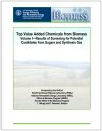What It Is:
Rational Molecular Design for Reduced Toxicity is the use of information from empirical, mechanistic and computational methods to create chemicals that are less toxic to humans and the environment.
How It Relates to Green Chemistry:
Hundreds of thousands of chemicals are currently in use. They are the basis of the products and processes we depend on in nearly every aspect of our lives. However, only a small percentage of those available chemicals have been tested for safety.
It is the fundamental responsibility of chemists to design and synthesize safe chemicals. In order to reduce toxics in the products we already use and in their supply chains, future molecules must be built with intention and with the whole life cycle in mind. This perspective can enable chemists to prioritize safety, even in earliest stages of chemical design.
-
- Design Safer Chemicals – utilizing all available information – hazard data, computational toxicity models, mechanistic studies – helps ensure a novel compound or new process achieves the desired function with minimized toxicity
- Eliminate and Minimize Hazards and Pollution – many chemicals persist in the environment or bioaccumulate in animals, which can negatively impact ecosystems. Designing chemicals that are inherently non-hazardous and that safely degrade or can be recycled is a key component of green chemistry!
-
Paints
Procter & Gamble, with Cook Composites and Polymers, developed a formulation of vegetable oil and sugar to replace petroleum-derived paint resins and solvents. The new biobased paint uses half as much solvent, improving worker safety and reducing indoor fumes from drying paint. (PGCCA 2009)
Antifoulants
Fouling costs the shipping industry billions of dollars each year in fuel consumption. To combat this, boat antifoulants are used to control the accumulation of plants and marine life on ship hulls. Traditional antifoulants often contain organotin compounds, such as tributyltin oxide (TBTO). These compounds are highly persistent in the environment and are toxic to marine life. Rohm and Haas Co. developed Sea-NineTM, a novel antifoulant to replace environmentally persistent and toxic tin-containing antifoulants. Testing chemicals for safety before they are put on the market is critical for preventing negative human health and environmental impact. In this case, over 140 compounds were tested to ensure that the new antifoulant would truly be a safer alternative. (PGCCA 1996)
-
A Probabilistic Diagram to Safer Chemical Design Against Cytotoxicity (The Nexus, 2017)
Rational Design of Safer Chemicals (Webinar, 2012)
Nanomaterials Design Guided by the Principles of Green Chemistry (Webinar, 2017)
-

Molecular Design—Concepts and Applications - An introductory textbook on molecular design, covering computer-based methods that can model a chemical being designed

Molecular Design for Hazard Reduction Using Green Chemistry - Connecting synthetic chemistry and molecular hazard characterization this dissertation includes an overview of current practices in both fields, and assembles disparate and anecdotal data to present a framework for how to design safer chemicals

Towards rational molecular design—derivation of property guidelines for reduced acute aquatic toxicity - A paper proposing design guidelines that can be used to increase the probability that a chemical will have reduced acute toxicity to multiple species

Towards rational molecular design for reduced chronic aquatic toxicity - A paper proposing design guidelines that can be used to increase the probability that a chemical will have reduced chronic toxicity to multiple species


